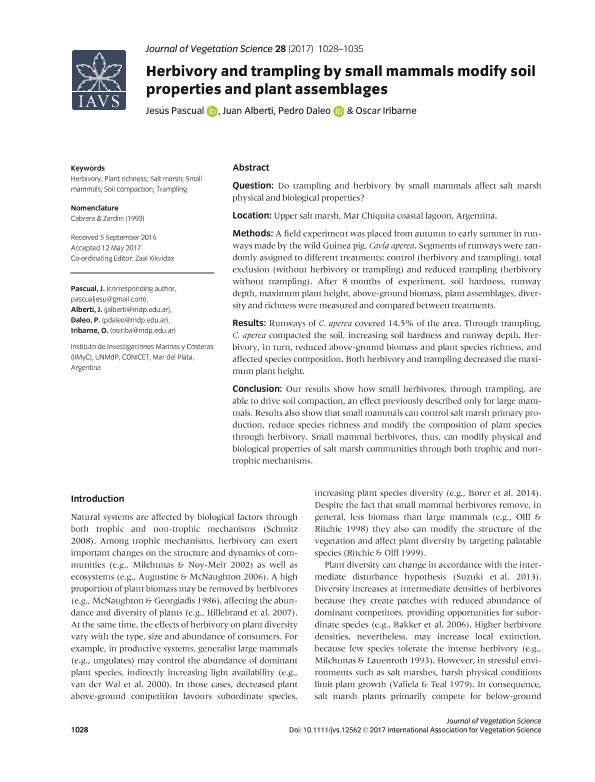Artículo
Herbivory and trampling by small mammals modify soil properties and plant assemblages
Fecha de publicación:
09/2017
Editorial:
Wiley Blackwell Publishing, Inc
Revista:
Journal of Vegetation Science
ISSN:
1100-9233
Idioma:
Inglés
Tipo de recurso:
Artículo publicado
Clasificación temática:
Resumen
Question: Do trampling and herbivory by small mammals affect salt marsh physical and biological properties?. Location: Upper salt marsh, Mar Chiquita coastal lagoon, Argentina. Methods: A field experiment was placed from autumn to early summer in runways made by the wild Guinea pig, Cavia aperea. Segments of runways were randomly assigned to different treatments: control (herbivory and trampling), total exclusion (without herbivory or trampling) and reduced trampling (herbivory without trampling). After 8 months of experiment, soil hardness, runway depth, maximum plant height, above-ground biomass, plant assemblages, diversity and richness were measured and compared between treatments. Results: Runways of C. aperea covered 14.5% of the area. Through trampling, C. aperea compacted the soil, increasing soil hardness and runway depth. Herbivory, in turn, reduced above-ground biomass and plant species richness, and affected species composition. Both herbivory and trampling decreased the maximum plant height. Conclusion: Our results show how small herbivores, through trampling, are able to drive soil compaction, an effect previously described only for large mammals. Results also show that small mammals can control salt marsh primary production, reduce species richness and modify the composition of plant species through herbivory. Small mammal herbivores, thus, can modify physical and biological properties of salt marsh communities through both trophic and non-trophic mechanisms.
Palabras clave:
Herbivory
,
Plant Richness
,
Salt Marsh
,
Small Mammals
,
Soil Compaction
,
Trampling
Archivos asociados
Licencia
Identificadores
Colecciones
Articulos(IIMYC)
Articulos de INSTITUTO DE INVESTIGACIONES MARINAS Y COSTERAS
Articulos de INSTITUTO DE INVESTIGACIONES MARINAS Y COSTERAS
Citación
Pascual, Jesus Maria; Alberti, Juan; Daleo, Pedro; Iribarne, Oscar Osvaldo; Herbivory and trampling by small mammals modify soil properties and plant assemblages; Wiley Blackwell Publishing, Inc; Journal of Vegetation Science; 28; 5; 9-2017; 1028-1035
Compartir
Altmétricas




